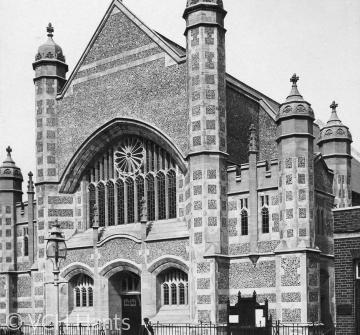Wesleyan Methodism in Basingstoke c1870 to 1939

From putting down permanent roots in the 1870s until the outbreak of the Second World War, Wesleyan Methodists made a notable contribution to the religious life of Basingstoke. Throughout this period their principal place of worship was in Church Street, opposite the Parish Church of St Michaels. Their first chapel, dating from 1876, was moved to Cliddesden in the early 1900s and replaced by a much larger and more imposing edifice opened in 1905.
As the lead church of the Basingstoke Wesleyan Methodist circuit, the Church Street congregation had the privilege of hearing the superintendent minister preach more frequently than those of the other churches. Ministers included the Revd William P. Ellis who in 1872 was appointed by the Wesleyan Conference as ‘the first home missionary’ in the town, where he served until 1876; the Revd Samuel Miles (1876-79) under whose ‘faithful labours the little cause became well rooted’; the Revd J. Robinson Cleminson (1884-87) ‘a prince of builders’ who oversaw substantial improvements to the chapel; the Revd Samuel Oliver (1890-93) whose ‘winning manners and courteous gentlemanly demeanour … made him easily accessible even to the humblest member of his flock’; the Revd Harold Chapman (1903-08) ‘a cultured and devoted minister’, who had the privilege of being in post when the new church was opened; the Revd Walter Barnes (1912-15) for the ‘strong leadership he provided’; the Revd James Ash Parsons (1927-31) ‘a fine example of muscular Christianity’; and the Revd Walter Weddell (1936-44) remembered for his ‘kindness, sympathy, cheerfulness and manliness.’
The Wesleyans were also fortunate in having some long-serving and committed laymen such as Edward Kynaston, who served as Sunday School Superintendent for many years in the late nineteenth and early twentieth centuries, and William Higgs, the Circuit Chapel Secretary during the same period. They enabled the Church to support a wide variety of affiliated organisations, such as a thriving Sunday school; from 1897, a branch of the Wesley Guild; for a number of years in the late 1870s/early 1880s, a Mutual Improvement Association; and for women a Ladies Sewing Party/Meeting and Women’s Bright Hour. These together with the regular services and those for special occasions and many ad hoc activities, including support for both home and overseas missions, offered both social and spiritual sustenance to many residents of Basingstoke. While major fund raising events provided a welcome diversion from the routine of everyday life.
(For the source of the quotations please see the asset)
Roger Ottewill
April 2019
Content derived during research for the new VCH Hampshire volume, Basingstoke and its surroundings.


